Kao Begins Verification Testing for a Used Disposable Diaper Carbonization Recycling System in Kamikatsu, Japan
Aiming to Address Issues with Processing Used Disposable Diapers and Reducing CO2 Emissions
Kao Corporation, a leading manufacturer of personal care and household products, cosmetics and specialty chemicals, which has been conducting research and development on a used disposable diaper carbonization recycling system since 2021, will begin verification testing in the town of Kamikatsu, Tokushima Prefecture, Japan. In this verification testing, used disposable diapers will be processed into semi-carbonized material*1 in the carbonization equipment developed, and methods for using the material locally will be explored. Used disposable diapers produce CO2 emissions when incinerated; in addition to addressing the issue of how to process used disposable diapers, this test aims to use the material as an alternative to fossil fuels in order to reduce CO2 emissions. This new approach differs from that announced in 2023 to fix carbon using semi-carbonized material for soil amendment*2 and is a continuation of ongoing verification testing started in the city of Saijo, Ehime Prefecture, in 2021.
-
* 1 Material rich in carbon, as the preliminary stage to carbonization through thermal decomposition.
-
* 2 Used disposable diapers produce CO2 emissions when incinerated; semi-carbonizing in carbonization equipment fixes the carbon, which can reduce CO2 emissions.
Kao News Release dated February 2023: Progress in Verification Testing of a Used Disposable Diaper Carbonization Recycling System in Japan
Background
From 2.45 million to 2.61 million tons of used disposable diapers are expected to be discarded as trash by FY2030, comprising between 6.6–7.1% of domestic waste*3 . The diapers also contain a large amount of moisture, which can degrade incinerator combustion efficiency. As the use of disposable diapers for adults increases with population aging, processing of such waste will place an increased burden on municipalities.
The Used Disposable Diaper Carbonization Recycling System
Kao’s aim is to set up a system for converting used disposable diapers to semi-carbonized material to solve waste disposal issues and reduce CO2 emissions.
As a step toward achieving this, Kao is developing carbonization equipment for converting used disposable diapers into semi-carbonized material. Utilizing Kao’s unique thermal decomposition technology employing low-temperature reactions to remove moisture, the diapers are processed into semi-carbonized material rich in carbon. The process sterilizes and deodorizes, which takes care of hygiene issues, and the waste can be treated where it is generated. Waste volume is also reduced, which facilitates collection.
Depending on the wishes of the community, the semi-carbonized material can be used for soil amendment or as fuel. In addition to the existing method for fixing carbon in semi-carbonized material, these two methods, which use the material an alternative to fossil fuels, can contribute to reducing CO2 emissions.

Verification Testing in Saijo, Ehime Prefecture (From January 2021, Ongoing)
In November 2021, the first carbonization device developed by Kao was installed at a childcare facility in Saijo. The device reduced diaper waste volume by 95% and has successfully produced semi-carbonized material rich in carbon. Furthermore, this material has a high calorific value and it was determined that it can be used as an alternative to fossil fuels. Since used disposable diapers are usually incinerated as domestic waste, producing CO2 emissions, using the material as an alternative fuel can reduce CO2 emissions.
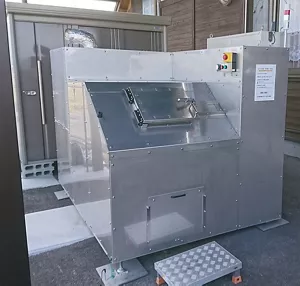
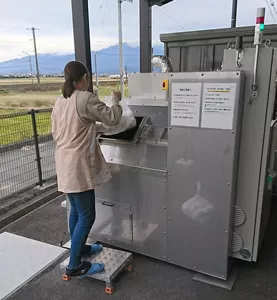
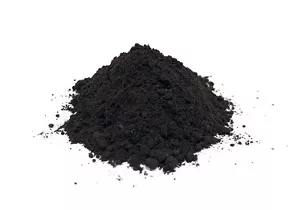
From left: the carbonization equipment developed by Kao; depositing used disposable diapers in the device; semi-carbonized material.
Verification Testing in Kamikatsu, Tokushima Prefecture (From October 2025)
Verification testing in Kamikatsu will start with the goal of social implementation of the recycling system. A second device will be installed in the trash sorting station in the Kamikatsu Zero Waste Center WHY*4 . Compared to the first one installed in Saijo, which could process 30 kg of waste at a time, the second device can process 50 kg each time, allowing more waste to be processed at one time. The second device is also more energy-efficient than the first.
In the verification testing, the carbonization equipment processes used disposable diapers brought in by residents. Testing involves determining whether the system is easy for everyone, including older persons, to use on a daily basis. In the future, the semi-carbonized material processed in the system will be used as an alternative to fossil fuels.
Kao and the town of Kamikatsu have entered into a comprehensive agreement regarding conducting the verification testing.
-
* 4 The base for communicating Kamikatsu’s zero waste initiative.
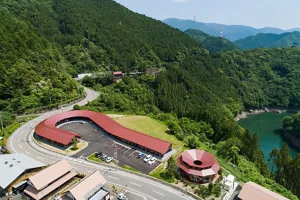
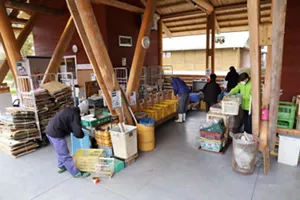
From left: Aerial view of the Kamikatsu Zero Waste Center WHY; inside the trash sorting station.
Summary
This verification testing developed out of Kao’s initiative, begun in 2021, to set up a used disposable diaper carbonization recycling system. In addition to utilizing semi-carbonized material by carbon fixing, this new approach has developed a way of using the material locally as fuel. In verification testing in Kamikatsu, factors necessary for social implementation in large facilities such as hospitals will be clarified with a view to implementing the system after 2025. It is hoped that these initiatives will help turn used disposable diapers into a resource, to help solve issues related to processing the used diapers and reduce CO2 emissions.
Related Information
-
* This news release is a translation of a Japanese-language news release dated October 1, 2025.
About the Kirei Lifestyle Plan
Over the past 130 years, Kao has worked to improve people’s lives and help them realize more sustainable lifestyles—a Kirei Lifestyle. The Japanese word “kirei” describes something that is clean, well-ordered, and beautiful all at once. For Kao, this concept of “kirei” not only describes appearance but also attitude—a desire to create beauty for oneself, for other people, and for the natural world around us. Aiming to realize a more sustainable way of living, in April 2019, the Kao Group established its ESG strategy known as the Kirei Lifestyle Plan. By 2030, Kao aims to empower at least 1 billion people, to enjoy more beautiful lives. Kao also strives to have 100% of its products leave a full lifecycle environmental footprint that science says our natural world can safely absorb.
Please visit the Kao sustainability website for more information.
About Kao
Kao, a Japan-based manufacturer of personal care and household products, cosmetics, and specialty chemicals creates high-value-added products and services that provide care and enrichment for the life of all people and the planet. Through its brands such as Attack laundry detergent, Bioré and Jergens skin care products, Laurier sanitary products, Curél, SENSAI, and MOLTON BROWN cosmetics, and Oribe hair care products, Kao is part of the everyday lives of people across Asia, the Americas, Europe, the Middle East, and Africa. Combined with its chemical business, which contributes to a wide range of industries, Kao generates about 1,630 billion yen in annual sales. Kao employs about 32,600 people worldwide and has more than 130 years of history in innovation. As an enterprise that provides products people use on a daily basis, the Kao Group takes responsibility to actively reduce the environmental footprint of its products throughout the product lifecycle. This is laid out in Kao’s ESG strategy, the Kirei Lifestyle Plan, which launched in 2019.
Please visit the Kao Group website for additional information.
Media inquiries should be directed to:
Public Relations
Kao Corporation
